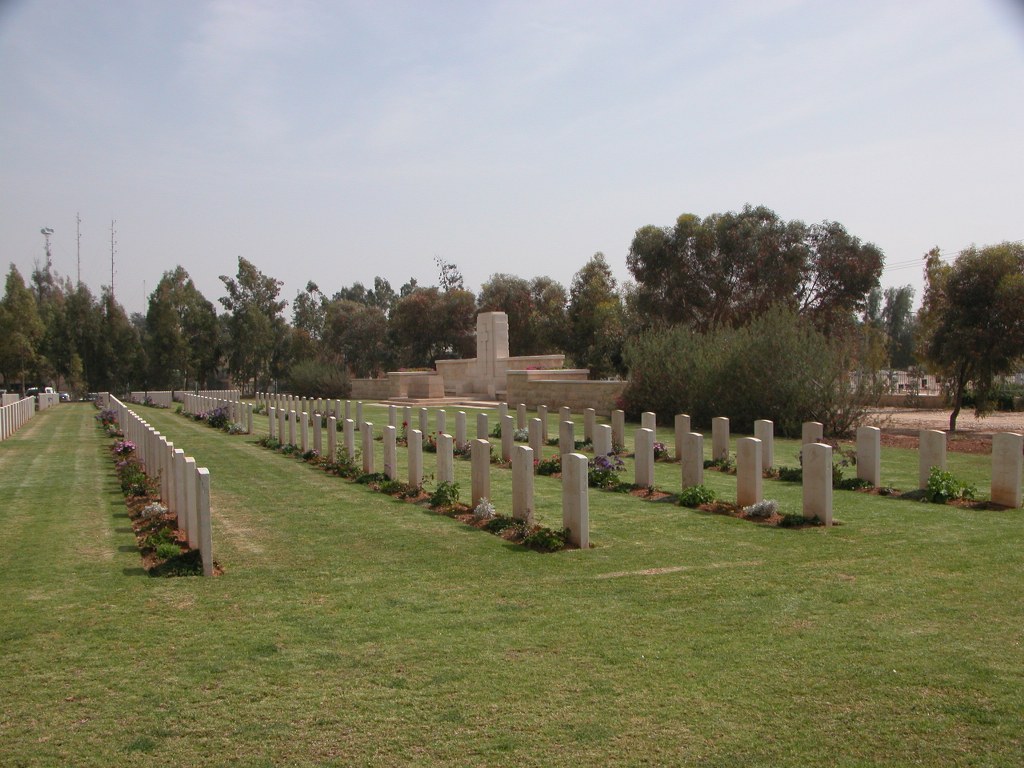Beersheba War Cemetery
- Country Israel and Palestine (including Gaza)
- Total identified casualties 1178 Find these casualties
- Identified casualties from First World War
- GPS Coordinates Latitude: 31.24417, Longitude: 34.78391
Location information
Beersheba is a southern town on the edge of the Negev Desert, 75 kilometres south-west of Jerusalem.
The Cemetery is situated on the south-west of Beersheba town. On arrival in the town via route 40, continue on until you reach a large junction with a shopping complex on your left. Turn right onto road No. 25, sign-posted Hazerim. Follow this road for 2 kilometres, turning left at the traffic lights opposite the high rise blocks, sign-posted Hazerim. The cemetery will be found on the left.
Owing to the one way road system, you must do a complete tour to reach the entrance so continue and turn left at the next set of traffic lights. Then take the next left onto Harzfeld Street. At the end of this street, turn left and the cemetery entrance is on your left.
Visiting information
The Cemetery is permanently open and may be visited at any time.
Wheelchair access to the cemetery is possible via the main entrance.
For further information and enquiries please contact enquiries@cwgc.org
History information
By October 1917, General Allenby's force had been entrenched in front of a strong Turkish position along the Gaza-Beersheba road for some months, but they were now ready to launch an attack with Beersheba as its first objective. On 31 October, the attack was carried out by the XXth Corps (10th, 53rd, 60th and 74th Divisions) on the west, and the Desert Mounted Corps on the east. That evening the 4th Australian Light Horse Brigade charged over the Turkish trenches into the town.
The cemetery was made immediately after the fall of the town, adjacent to Beersheba Christian Cemetery and remained in use until July 1918. The burials during this period numbered 139. It was greatly increased after the Armistice when burials were brought in from a number of scattered sites and the following small burial grounds:-
ABUSHAR WADI MILITARY GRAVES. These were a group of 44 graves of men of the 60th (London) Division who fell on the 31 October 1917, on the South-West side of Beersheba.
HAREIRA DISTRICT MILITARY GRAVES. Abu Hareira is about midway on the road from Beersheba to Gaza, in front of the Wadi el Sheria. The Turkish lines here were attacked and captured by the 10th, 60th (London) and 74th (Yeomanry) Divisions on 6 and 7 November; and 81 men, chiefly of the 60th Division, were buried in the neighbourhood.
IMARA MILITARY CEMETERY, about midway between Beersheba and Rafa, contained 125 graves of men of various units who fell, for the most part, in November 1917.
IRGEIG DISTRICT MILITARY GRAVES. Abu Irgeig is about 6 miles North-West of Beersheba, on the road to Gaza, and was occupied by the 53rd (Welsh) Division before the capture of Beersheba. Three hundred and one men of various units, who fell for the most part in November 1917, were buried in the neighbourhood.
JERWAL DISTRICT MILITARY GRAVES. In the district immediately North of Beersheba were 382 graves of men, mainly of the 53rd (Welsh) Division, who fell in the operations following the capture of Beersheba.
TEL EL FARA MILITARY CEMETERY. Tel el Fara is about 18 miles West of Beersheba, and was important as a station on the railway line from Rafa. Thirty men of various units, who fell in the period June to October 1917, were buried in the Military Cemetery.
WADI HALGON MILITARY CEMETERY. In this Cemetery, on the South-West side of Beersheba, were buried 30 men of the 60th (London) Division, who fell in the capture of the town.
YAHIA DISTRICT MILITARY GRAVES. These were the graves of 150 men of the 53rd, 60th and 74th Divisions who fell in the infantry attacks West of Beersheba.
YEBNA DISTRICT MILITARY GRAVES. Yebna is about 40 miles North of Beersheba and 12 miles South of Jaffa, on the Gaza-Jaffa railway line. It was captured by the Imperial Camel Corps and Yeomanry on 13 November; and 69 men, who fell then or later in the war, were buried in the neighbourhood.
The cemetery now contains 1,239 Commonwealth burials of the First World War, 66 of them unidentified. The cemetery was designed by Sir John Burnet and was consecrated by the Bishop of Jerusalem on 22 March 1923.







